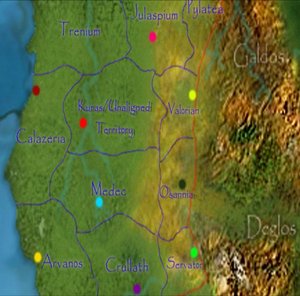Kuras
Note: This information refers to the Third Imperium Age. As of the 2200s, the City of Kuras remains independent. See: Fourth Imperium Age
Kuras the capital of the Kurathene Empire, is a large, well fortified city located on the bank of the Nomad River in the central part of Kurathene. The largest city found north of the Seven Cities, Kuras has grown from a small tribal settlement in the early Third century P.O.D. into a city rivaled only by the likes of Andarr and Crosstreams as the greatest on the
continent. Its geographic location and extensive Imperial road system
established by the long reign of the Kuras family make it an ideal locale
for the seat of Imperial power.
The majority of architecture and organizational systems used by the other cities of Kurathene originate from the highly structured and orderly system first implemented in Kuras. While the other cities have established their own unique and in some ways improved systems of administration and construction, their underlying organization is still heavily influenced by the Kurasian style established by Mantith Kurath.
With the fall of the Empire the fortunes of Kuras have generally waned as the prefectural capitals began exerting more influence. The city is still heavily populated, with a total population numbering one and a quarter million inhabitants, but it is generally agreed that the city is no longer the same, vibrant entity that it had been during the administration of the Empire. Despite this decline, the city maintains a vital strategic and symbolic importance to the people of Kurathene, becoming something of the crown and scepter, a symbol required to legitimize one's claim to the throne.
- by Nob, Fuzz, Orleron
History

The origins of the city can be traced back to the year 347 P.O.D. when a human tribe lead by a man named Rokel Kurath began a migratory existence near the central bank of the Nomad River. There is some evidence of a small fortress located within ten miles of present day Kuras, though this is widely regarded as an abandoned settlement originally laid down by Tomil towards the end of the Fourth Century P.O.D.
Formally the city began life as the settlement of Centerpoint in the year 315, as Tomil Kurath requiring a base of operations for his vast responsibilities as Overseer of the plains began construction of a large, permanent fortification within which to house his forces. Although Tomil could have been said to have acquired the deed to the future city, the first foundations of its greatness were laid down by his son, Mantith Kurath. A visionary rivaled only by his descendent Joral Kuras, Mantith began a series of construction initiatives which provided not only military mobility to the city, but also helped cement its position as the cross-roads of the growing plains nation.
Despite being economically vibrant and militarily well defended, Centerpoint did not truly attain its status as a large metropolitan area until the reign of Lucien Kuras. With the establishment of the Kurathene Republic in 195 P.O.D. the growth of Centerpoint's population and economy increased rapidly as bureaucrats flocked to the Republic's capital with followers and merchants in tow.
However important these events were for the rapidly growing and maturing city of Centerpoint, the succession of Joral Kuras to the title of Kurath would overshadow them all in terms of influence. As a young man of a mere seventeen years of age during his ascension, Joral spent an inordinate amount of time fussing over the legislation of the Republican capital, suggesting grand construction projects and reorganization whenever he was not at the frontlines of battle. Coincidentally these improvements were to make the capital all but unassailable during the War of Unification.
With the conclusion of the War of Unification in 15 O.D., the city was renamed Kuras to commemorate the establishment of the Imperial Republic and the seat of government within its boundaries. What followed was a millennium of unprecedented growth fueled by the ambition and energy of Joral Kuras.
Prospering as the Empire grew; the city of Kuras became the first city to boast a population of the milestones of one million, two million and three million inhabitants in 474 O.D., 772 and 1078 respectively. The population began slowly decreasing again around 1480 as the city of Medec began growing in importance and several reforms in both Caliaze and Trenium made land ownership in those lands more accessible. Despite these changes, Kuras continued to thrive as the capital, with the total revenue in trade increasing at a steady and perceptible rate over the next three hundred years.
The city suffered an abrupt change of fortunes in 1825 O.D. with the death of Joral Kuras at the hands of Nemeril. In addition to the severe and lasting damage to the city's infrastructure in the ensuing battle, the Imperial government's sudden collapse meant that much of the trade and politics which had long sustained the city's economy vanished in a wisp of smoke.
Repeated attempts at invading and occupying the city were made in the early-mid 1830s, though these were all repelled by the Imperial Order remnants in the city proper. One result of these attacks was that the faith of Senath was largely ostracized in Kurasian circles, many of its clergy being either banned outright or removed from posts of power. The state of martial law in the city itself has continued unabated for the last two hundred years, as nobles with ambitions for the Crown continue to attempt capture of the city to aid their legitimacy.
In Game Developments
- Major Meeting Points in Kuras
- Kuras Forum
- Kuras Marketplace
- Events and Rumours
- Notable PCs of Kuras
- Recent Events in Kuras
